Halo 3 ODST review
You’d have to have been living on a desert island for the last few years (and one without an internet connection at that) not to have heard of Halo. The first game showed the world the real potential that lay ahead for console online multiplayer gaming (and for a while, at least, silenced the multitude of PC owners who’d been ranting on for years that you ‘couldn’t do proper multiplayer deathmatch on a console’) as well as introducing the gaming world to the Master Chief, one of the coolest and most instantly recognisable characters to hit the videogame console since the delectable Ms Lara Croft graced the PlayStation, many years before. I’ll admit, that like most of the gaming community, I was sucked into Halo’s world, its action and its storyline, and I loved every minute of it.
But to be honest, since then, each episode of Halo has left me feeling just a little less moved. Maybe it’s because each of them is hyped as the biggest event in gaming since… well, since the first Halo, but – for me at least – each then fails to quite live up to its promise. Oh don’t get me wrong, they all looked great and offered more deathmatch maps, new options, etc, but nothing quite matched the thrill of the first game, up to and including the recent Halo 3, which for me just couldn’t compare in either single-player campaign mode or the online deathmatch options to something like Call Of Duty 4.
All that aside though, I was still extremely keen to get my hands on the latest in the Halo series, Halo 3: ODST. Not so much a sequel as a spin-off, this game takes the focus away from the super-human, super-cool Master Chief, and revolves instead around the soldiers of the elite division of the United Nations Space Command Marine Corps, the Orbital Drop Shock Troopers – basically the USNC’s futuristic equivalent of the British SAS or the US Navy SEAL teams. If there’s a situation that’s too tough for the cannon-fodder UNSC grunts (who you’ll have seen massacred by the dropship-load in Halo 1, 2 & 3) to handle, then the ODST, or ‘Helljumpers’, are the guys you call.
Our story starts with the Helljumpers deploying from orbit aboard their USNC transport on a hush-hush mission via their signature single-person drop pods. Unfortunately, everything doesn’t quite go according to plan, and things get a little ‘lopsided’ just as the ODST deploy into action, when a massive energy burst close to the planet’s orbit sends their pods tumbling off course and out of control, with the result that the team winds up getting separated and crash-landing at a variety of locations. This means that you, the rookie of the squad (called, rather imaginatively, ‘Rookie’) have to spend a fair part of the game tracking down and locating the scattered squad members before the mission can continue.
What this basically amounts to, at least to begin with, is wandering through a very dark urban cityscape, battling hordes of the alien Covenant troops and trying to locate waypoints which trigger new instructions and various ‘cutaway-missions’ that let you play the landing from the perspective of each of the different squad members. Did I say ‘very dark urban cityscape’? Make that: very, very, very, VERY dark urban cityscape! Because in a lot of these urban levels, you really can’t see your hand in front of your face – it’s THAT dark. In fact the only way you can see anything at all is by making use of your helmet’s VISR, which is basically a low-light vision system coupled with a targeting aid that marks enemy targets in red and the ‘home team’ in green.
Now to begin with, these dark levels are quite atmospheric and eerie, as I’m sure they’re meant to be. As you wander through the shadowy world, with suitably tense incidental music to match the mood, it’s quite nerve-wracking… at least for the first 10 minutes or so. After that though, it starts to get annoying. You find yourself wishing for some decent lighting, as yet another shadowy Covenant soldier shoots at you from behind a shadowy obstacle in the shadow of a big shadowy building… you start thinking that it’d be nice if you could just have a gun with a big flashlight fitted on the end instead of the VISR, which gives about the level of illumination you get when you first turn on an energy-saving light bulb, before it warms up (ie: not much). This is particularly bad inside of buildings, where you often find yourself bouncing off the walls trying to find your way out, and the darkness gets to be so oppressive that when you eventually do get to a cutaway mission which is set outside in broad daylight, it’s such a relief that you almost don’t want to finish it for fear of then getting dumped back in the Rookie’s twilight world.
It’s not just the darkness of much of the game that left me feeling a little cold either, it’s the sense that everything in this game I’ve done before. I’m shooting the same aliens, using the same weapons, driving the same vehicles… to put it simply: it’s basically Halo, as I remember it, but nothing’s really new. Yes, it looks shinier (when it’s not pitch black that is) and yes there are new levels and new characters, but frankly, for me it’s just more of the same, and personally I’m starting to get a little bored with it.
So… am I gonna recommend giving this one a miss? Well… no, actually. And that’s for two reasons. For one, I know that while I might have reached my fill of samey Halo storylines and repetitive Covenant-blasting combat, there’s a massive section of the Xbox-owning public out there that hasn’t. They’re the ones who are buying the Halo books and toys, logging onto the fansites, even making their own Halo-themed TV shows, and for them, they’ll probably love every minute of this game. A game being very similar to something you’ve played previously isn’t a bad thing in everyone’s book – just look at the oodles of gamers who year on year buy each new EA Sports update, each of which is almost always essentially the same as last year’s instalment, just with slightly more polished graphics and some updated stats.
The second reason that Halo 3: ODST doesn’t get a negative review is that when it comes to Halo, the single-player (and indeed, two-player co-op) Campaign mode is only a small part of what everyone loves about the series. The other thing is the online multiplayer, and this is where Halo 3: ODST really delivers. A whole second disc comes in the box, and is packed with online features including 24 different multiplayer maps which takes in all the ones from Halo 3, the DIY Sandbox option and three brand new maps. In addition, up to four friends can play either online or via system link in a new co-op mode called Firefight, which is basically a cooperative ‘survival’ mode, similar to Call Of Duty: World At War’s zombie level which faces players with wave after wave of ever-more-demented Covenant troops.
And no matter how bored I might think I am with the single-player action and storyline of Halo, I simply can’t keep away from the online deathmatch mode, which is the reason that, while this game would probably get just an average 5 out of 10 on the single-player mode alone, it actually gets a deserving ‘very good’ 7 out of 10 rating for the overall package.
Get Halo 3 ODST now
New: Buy Halo 3 ODST from Amazon.com
Related: Halo 3 review, Halo Wars review




